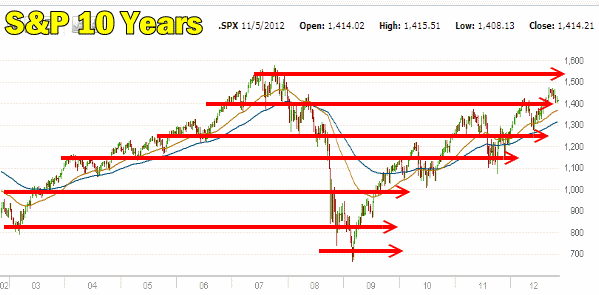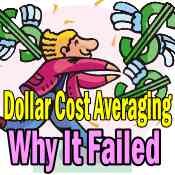Yesterday I posted a portion of the article I wrote for the members section on the 9 investing myths that investors need to be aware of and forget. The preview I posted was on the fallacy of one of the oldest investing ideas since the 1970’s and that was dollar cost averaging. This morning I read with great interest that the mutual fund giant Vanguard Group had completed an intensive study comparing lump sum investing versus dollar cost averaging and came to the conclusion that dollar cost averaging is a poor strategy.
Dollar Cost Averaging Failure
To investigate Dollar Cost Averaging Vanguard studied two lump sum investments of $1 million and $20 million and ran computer simulations rolling these simulations every ten years starting in February 1926 and completing in December 2011. This means that all the major corrections and stock market crashes including 1929, 1932, 1973-74, 1987, 1998, 1999, 2000-2003 and 2008 were included in their Dollar Cost Averaging study.
They then compared the results against an investor who placed capital into stocks at set periods through the same time frames using the Dollar Cost Averaging method. The computer simulations were ran and analyzed. The same Dollar Cost Averaging algorithms used were on the US stock markets and on the United Kingdom and Australian stock markets.
The evidence against Dollar Cost Averaging was overwhelming. Dollar cost averaging fails as an investment strategy when compared to lump sum investing. Vanguard went even further in their report indicating that their studies show that dollar cost averaging ends up hurting more investors than it helps.
Why Dollar Cost Averaging Was Popular
Dollar Cost Averaging was chosen by investment dealers and counsellors because they felt it smoothed out the collapses and inevitable corrections. But didn’t anyone think that by smoothing out the best money-making buy opportunities they would also be dampening returns? This is exactly the downfall of Dollar Cost Averaging.
It was obvious to me in the 1970’s that dollar cost averaging was a poor idea and here’s how I found out.
The Bear Market Of 1973 to 1974
In the bear market of 1973-1974 I was with a mentor and still learning the investing ropes. I was surprised how each day as the markets fell lower as the economic world seemed to be coming unglued my mentor kept getting more and more excited. When we finally bought stocks and a handful of options (there weren’t many stocks with options in 1974), I thought my mentor was on the verge of insanity. I was lining up to buy gas, there were all kinds of rumours of war in the Middle East as the oil embargo was underway, North Vietnam was invading South Vietnam and the Watergate affair was underway. Housing prices were going nowhere and my mortgage had just gone up big time. I really thought why in the world am I risking everything and when Businessweek released their magazine that year with the headline “Death Of Equities” I felt everything I believed was confirmed. We were on the verge of a Depression the likes of which would make the 1930’s seem like a picnic. I am amazed I didn’t develop ulcers.
Triple Digit Gains
But my mentor was right and I was wrong. He took my small little portfolio of barely $28,000 and turned it into $75,000 within a year and a half and into $127,000 by the end of the decade. I was stunned. He told me that you always want cash available. He advised that there are always opportunities but when stocks plunge and the world seems to be falling apart, all stocks, good and bad will go for fire sale prices. He was right as many of the stocks we bought more than tripled by the end of the decade.
He was the first investor I met who mentioned to me that Dollar Cost Averaging was an up and coming trend and that it was a big mistake. He said then that it was an excellent way for investors to pay commissions and for brokers to “reel in clients”.
He told me then that the downfall of Dollar Cost Averaging would some day be realized but any investor who thought about Dollar Cost Averaging would realize it was a mistake. He told me then that keeping a portion of a portfolio in cash can give investors the kinds of returns they need to grow their capital quickly. Since he had survived the Great Depression I figured he must have known what he was talking about.
Think About What Dollar Cost Averaging Is Doing
All any investor has to do is look at a 10 year chart of the market to understand why Dollar Cost Averaging fails as a strategy. Here is the 10 year S&P 500 chart. I have marked with arrows all the different time periods when an investor would be Dollar Cost Averaging into a market ETF for example. It becomes obvious that an investor is continually buying the market throughout all the periods from low to high. Even though he is buying more at the lows and less at the highs, the majority of the buying is during the middle periods which means the investor has stacked his investments against earning the best returns. He basically is smoothing out his returns and earning far less. It’s strange to think that Vanguard would spend money studying this to come to the same conclusion.

How can any investor make decent returns by constantly buying the market through dollar cost averaging?
Dollar Cost Averaging Doomed From The Start
When you think about it, you realize that dollar cost averaging was doomed from the start. Think about how investors are putting money into the market at highs, middles and lows and it is obvious that the returns are going to be poor. Even if an investor puts less in at highs and more at lows, the fact that the investor keeps piling money in primarily during market rallies is the key aspect to understand why this investing method was a poor idea. While he is smoothing out the collapses he is actually limiting returns from the very best investing periods – market crashes and corrections.
I can only imagine how much money was spent on the Vanguard study when just taking a moment out and studying ETFs over 6 or 10 year periods can show that Dollar Cost Averaging is a poor strategy for any investor to consider.
It is obvious that the critical factor in investing is compounding returns, protecting capital from loss and benefiting from market direction plunges. This is why I invest with the strategies I have used since the world appeared ready to collapse in 1974. This is also why dollar cost averaging failed as a principal investment method.

